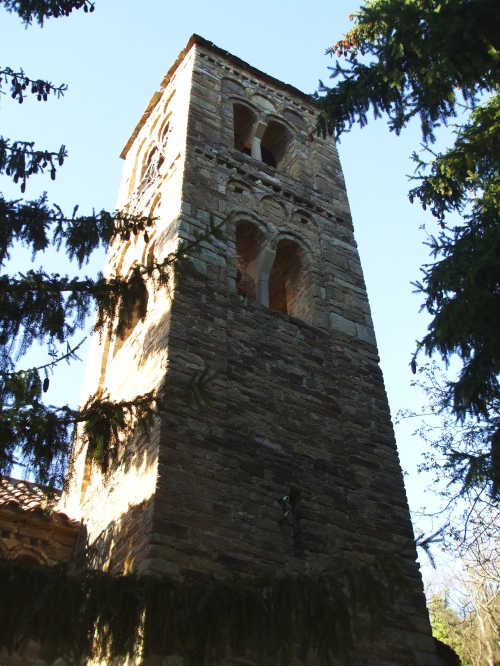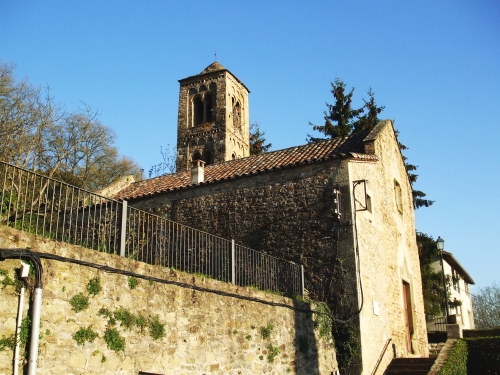I tried to write one more quick post before I went to Leeds. Unfortunately it turned out to need some corrections once I’d got at the literature, so it didn’t go up but you can have it now, while I reel and try to catch up on fifty things at once. It’s only short, as not only did I get only a few photos but there are some at least equally good ones of the relevant place up on Flickr already. I was taken here whilst on the way back from l’Esquerda in Professor Ollich’s car. It’s not the most interesting or even the most dramatic church setting in its immediate neighbourhood; that title belongs without doubt to Sant Feliuet de Savassona, which is not only in an incredible setting but also has burials beneath its craggy outcrop from the Late Bronze Age and the Iron Age, albeit only a few.1 It’s as if every fifteen hundred years or so someone has felt the need, for a short while only, to put some dead people there, which to my mind is a lot harder to explain than simple continuity. Anyway, down the hill from there and more on the way back from l’Esquerda there is what is at least a prettier church, Sant Esteve de Tavèrnoles, which looks, in part, like this.

Tower of Sant Esteve de Tavèrnoles
It’s basically a near-perfect little Catalan Romanesque church: twin arched windows, marked-off stories, arcaded friezes around the tops of them. There are some unusual features, however: the arcades at the apse end are blind windows, which is very hard to parallel at this date.

Apse of Sant Pere de Savassona
The other thing we can say about it is that its parish status is a bit odd.2 Pretty much everything here in the period that this building, at least, dates from, looms under the domination of Sant Pere de Casserres, the big vicecomital monastery just up the road, or else the cathedral of Sant Pere de Vic. Casserres, however, never had a parish of its own, and the outcrop church of Sant Feliu de Savassona was the first parish near Tavèrnoles. The church up there, as said, is so small that it’s now called Sant Feliuet, and when Sant Esteve is first mentioned, in a document of 981, it already has a parish that had apparently replaced Savassona’s.3 Eventually Savassona’s parish was recreated on a different church, Sant Pere; but Sant Esteve de Tavèrnoles somehow wound up as parish church to the declining monastery of Casserres, even so. All this probably says something about population movements and demographics, but it’s also all so late that there are almost certainly more detailed ways to get at that available in the sources; we’re talking twelfth-century stuff here. I didn’t have that information then so I just photographed stuff and got back in the car.

Sant Pere de Savassona in late afternoon sunlight
Now these are not the church’s finest aspects, really, and if you like pretty little churches caught in all their detail, do as I say have a look at this Flickr set. But that’s all I had and have time for, so I offer it anyway.
1. I’m sure there must be proper literature on the burials, but I know about them from Antoni Pladevall, Sant Pere de Casserres o la Presència de Cluny en Catalunya (Manlleu 2004), p. 48. On the church there is Joan-Albert Adell i Gisbert, Pladevall, Albert Benet i Clarà & Dolors Arumí i Gómez, “Sant Feliu de Savassona”, in Jordi Vigué (ed.), Catalunya Romànica III: Osona II (Barcelona 1986), pp. 616-618.
2. This section is based on Adell, Pladevall, Benet & Arumí, “Sant Esteve de Tavèrnoles”, ibid. pp. 618-623, and G. Orriols i Puig, Pladevall, Benet & Jordi Vigué i Viñas, “Sant Pere de Savassona”, ibid., pp. 614-616. As you can probably tell my first reaction when confronted with a church in my area is to run to the Catalunya Romànica. I dream one day of having enough shelf-space for the full set of it, it’s gorgeously produced and illustrated but absolutely huge.
3. The document is printed as Ramon Ordeig i Mata (ed.), Catalunya Carolíngia IV: els comtats d’Osona i Manresa, Memòries de la Secció històrico-arqueològica LIII (Barcelona 1999), doc. no. 1342. I realise that probably nobody needs to know that who reads in English but I hate it when authors mention that a document exists but don’t tell you what it is.


Wee pretty little church! Those blind windows are interesting, too… why not put actual windows in?
These are only guesses, but firstly having that much of the church open would probably make it very cold and it must have been bad enough anyway—I assume that glassing in that many windows would have been hard to manage;secondly, and this I would actually like to read more about, I think there is some effort with these buildings to make use of darkness to accentuate the service’s mystery and the effects of the internal lighting. There must be some work on this, I know there is on the way that Gothic uses light, but anyone who’s stood in a cavernous Romanesque nave with impossibly bright light streaming in a sharply delineated shaft from the few windows, marking off the shadows, must have felt some of the worry and wonder of the godfearing that that could have caused. (Some examples will feature in the post after next.) I think too much light would have been antithetical to the atmosphere these buildings were intended to create.
Gah, stupid hostel wireless ate my comment! I was going to say, that makes a reasonable amount of sense – darkness can be a pretty powerful liturgical tool. If I were at home and had the run of the library, instead of hiding in a slightly odd-smelling hostel, I have an inkling that this book might be a starting place…
Well, yes, I suspect you might be right! Thankyou for the pointer.
I think I’ve been away from home too long. *pokes dolefully at the Fisher catalogue*
If you’re in London still and can come up with an excuse you could comfort yourself with the Institute of Historical Research Library, which is moving out of its incredibly antiquated premises in Senate House next month but is currently still an open-shelf joy. Otherwise I can only counsel manuscripts, treasures, booze and parties as temporary library substitutes!
I’m holing up in the BL tomorrow… But it’s not the same, it’s not *my* library.
… yeah, I miss my library more than my own bed. Although it’s possible I miss my kitchen even more. *twitches* I haven’t cooked anything for nearly a MONTH. *twitches some more*